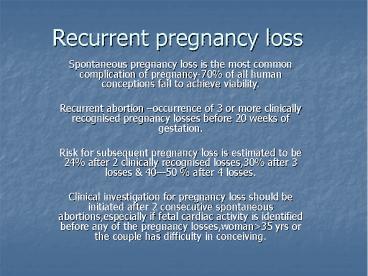Recurrent pregnancy loss PowerPoint PPT Presentation
Title: Recurrent pregnancy loss
1
Recurrent pregnancy loss
- Spontaneous pregnancy loss is the most common
complication of pregnancy-70 of all human
conceptions fail to achieve viability. - Recurrent abortion occurrence of 3 or more
clinically recognised pregnancy losses before 20
weeks of gestation. - Risk for subsequent pregnancy loss is estimated
to be 24 after 2 clinically recognised
losses,30 after 3 losses 4050 after 4
losses. - Clinical investigation for pregnancy loss should
be initiated after 2 consecutive spontaneous
abortions,especially if fetal cardiac activity is
identified before any of the pregnancy
losses,womangt35 yrs or the couple has difficulty
in conceiving.
2
History
- h/o consanguinity-single gene defects may cause
RPL revealed by a detailed family history. - Inherited thrombophilias can cause
RPL-hyperhomocystinemia,activated protein c
resistance,mutations in factor 5 leidein,protein
C,S,antithrombin 3 - Parental chromosomal abnormalities like balanced
translocations can cause RPL-cannot be ruled out
by family history or prior term births.
3
History
- h/o foul smelling vaginal discharge-suggestive
of bacterial vaginosis .infection with
ureaplasma,prevotella,b-hemolytic
streptococcus,mycoplasma,gardenella,chlamydia
have been implicated - Bacterial vaginosis-recurrent 2nd trimester loss.
4
History
- HSV,CMV cause direct infection of the
fetus,placenta-resulting villitis tissue
destruction-pregnancy disruption - Aqquired anatomic abnormalities-intrauterine
adhesions,endometriosis,uterine
fibroids.endometrium over fibroid/synechiae-inadeq
uately vascularised-abnormal placentation-spontane
ous pregnancy loss. - h/o any purulent discharge pv-endometritis,submuco
us fibroid polyp
5
History
- h/o mass abdomen-fibroids,chocolate cysts
- h/o pressure symptoms of fibroid-constipation
increased frequency of micturition - Exposure while in utero to maternal ingestion of
diethyl stilbesterol-hypoplasia/anatomical
abnormalities of uterus,cervix and
vagina,incomplete mullerian duct
fusion,incomplete septum resorption,cervical
incompetence. - Presence of intrauterine septum-60 risk of
spontaneous abortion-embryo implants on poorly
developed endometrium over septum-1st tri abortion
6
History
- h/o excessive vaginal mucoid discharge,wetness
may be suggestive of cervical incompetence-mostly
2nd tri abortions. - h/o exposure to any medications anti
progestins,antineoplastic agents,inhalational
anaesthetics - h/o exposure to ionising radiation/environmental
toxins-heavy metals. - h/o pain abdomen,bleeding/spotting pv in present
pregnancy
7
Menstrual history
- h/o menorrhagia-fibroid(submucous),uterine
malformations - h/o metrorrhagia-infected submucous fibroid polyp
- h/o dysmenorrhoea-endometriosis,adenomyosis
- h/o dyspareunia-endometriosis
8
Menstrual history
- h/o irregular short cycles-luteal phase
defect-inadequately/improperly timed endometrial
changes at implantation sites. - In LPD - LH levels causes premature aging of
oocyte and dys-synchronus maturation of
endometrium-recurrent preg.loss. - h/o irregular cycles with prolonged periods of
amenorrhoea-PCOD,,hyperprolactinemia,uterine
synechiae - PCOS- LH levels, androgen levels,insulin
resistance-pregnancy loss
9
Obstetric history
- To be taken in detail in chronological order of
events - Time after marriage the patient conceived,whether
she undertook any treatment for infertility - At what gestational age the prior pregnancy loss
occurred-whether it was associated with
pain/bleeding,whether it was followed by a check
curettage - Whether there was sudden painless loss of watery
fluid pv followed by expulsion of the fetus - Whether fetus was alive/dead if born alive how
long it lived - If IUD-fresh/macerated
- Sex/wt of the fetus
- h/o recurrent malpresentations in prior
pregnancies may suggest uterine malformations
10
- PAST HISTORY-
- h/o chronic HT,DM,TB,
- Overt DM-hyperglycemia-embryotoxic,advanced
IDDM-vascular complicatios-compromised blood flow
to uterus. - h/o hyper/hypothyroidism-thyroid
disease-ovulatory dysfunction,LPD. - Metabolic demands of early pregnancy mandates
requirement of thyroid hormones,so
hypothyroidism-recurrent preg.loss. - In clinically euthyroid patients-presence of
antithyroid antibodies may be associated with
RPL-due to generalised autoimmunity/impaired
ability of thyroid to meet demands of pregnancy.
11
- h/o connective tissue disorders,h/o thrombotic
events-suggestive of APAS-causes 3-5 of RPL. - Past surgical history-DC,MTP,check
curettage,amputation of cervix/cone
biopsy-cervical incompetence - h/o surgeries myomectomy/metroplasty
- FAMILY HISTORY-of recurrent spontaneous
abortions,chronic medical conditions,thrombotic
events - PERSONAL HISTORY-h/o smoking,tobacco
chewing,alcohol consumption/drugs-cocaine
12
Examination
- Obesity,hirsuitism,acanthosis,thyroid enlargement
- galactorrhoea-hyperprolactinemia
- Pallor-menorrhagia
- p/a-irregular contour of uterus may suggest
fibroids with pregnancy,bicornuate uterus - Cystic swellings with fixity/tenderness-endometrio
sis - malpresentations may be present
- P/S may show myomatous polyp protruding through
the os. - Bluish black puckered spots may be seen in the
posterior fornix-endometriosis - Congenital anatomical abnormalities may be
revealed.
13
Examination
- Whether cervix scarred-amputation/conisation
- Any signs of infection-tender swollen red vagina
in bacterial vaginosis.discharge from
cervix-endometritis - Estrogenisation of the tissues can be made out.
- During pregnancy-whether the os is open,if open
whether membranes are bulging thruogh os.periodic
inspection of the cervix from 10th week onwards
may be done weekly-dilatation of internal os with
herniation of membranes will be diagnostic. - In interconceptional period-passage of no6-8
hegars dilators beyond the internal os without
pain or resistance and absence of snap of
internal os on withdrawing it especially in the
premenstrual phase is suggestive of cervical
incompetence. - Bimanual pelvic examination-enlarged irregular
firm uterus-fibroid,retroverted fixed uterus,b/l
forniceal tenderness/mass cobblestone feel of
uterosacrals endometriosis - In adenomyosis-assymetrical enlargement of uterus
with tenderness

